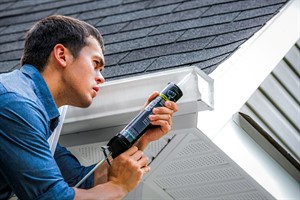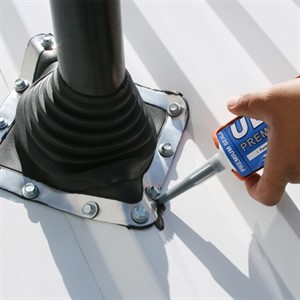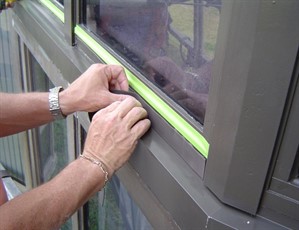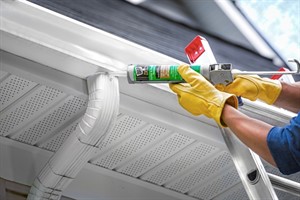
Avoid common errors with these sealant application tips
 |
| Photo courtesy of DAP Products Inc. |
Sealants play an integral role in the metal building envelope to seal between metal and other exterior materials. They form a barrier preventing the passage of water, moisture, air, noise, dust, smoke and airborne particles. Butyl tapes, non-drying butyl standing seam roof sealants, silicones and polyurethanes are common sealants used in metal construction. They can be applied to standing seams, metal end laps, roof penetrations, curbs, expansion joints, roof-to-wall transitions, roof steps and height changes, ridge expansions and gutter seams.
Although representing less than 1 percent of the structure, sealants’ correct application is critical to the water and airtightness of the building. Since metal substrates expand and contract with changes in temperature, sealants (they consist of polymers that allow flexibility) aid metal panel joints that experience dynamic movement. Here’s advice on how to ensure problem-free sealant application.
Clean and Dry
 |
| Photo courtesy of Triangle Fastener Corp. |
Improper or incomplete surface prep may be the number one cause of sealant application errors. Joe Stager, vice president of Triangle Fastener Corp., Cleveland, stresses never apply sealant on a dirty, dusty or wet surface, and always remove old sealant before applying new.
Clean the surface with a solvent such as mineral spirits or a lacquer thinner. When using solvents, always wipe the surface dry with a clean cloth or lint-less paper towels. Never allow a solvent to air dry or evaporate without wiping. For a nice, clean finish, apply masking tape to the sides of joints prior to filling voids. Ensure adequate ventilation during sealant application.
Jason Toth, technical customer service supervisor at DAP Products Inc., Baltimore, agrees, saying: “Extra care must be taken to ensure that bonding interfaces are clean, dry and at recommended application temperatures. Surface prep is always important; however, when dealing with slick, nonporous substrates, additional attention will be necessary.”
Follow Instructions
Cut the sealant tube nozzle to the desired bead size. Pierce the inner seal with a stiff wire or other similar object. Insert the sealant cartridge into the caulking/sealant gun. Squeeze with even, consistent pressure to control the rate at which the sealant leaves the tube. Push the bead of sealant ahead of the nozzle; this prevents air bubbles forming under the sealant. Use constant pressure on the trigger to ensure an even flow.
When finished, the tube can be stored. Replace the cap, or use a nail in the tube opening. Wipe hands with a dry cloth before washing with soap and water. To clean the area around the sealant, use mineral spirits for silicone, and soap and water for acrylic.
Butyl Tapes
Butyl tapes can be applied to single-skin metal panel seals, end laps and side laps, and also under roof curbs, under fasteners and other applications where the butyl tape is covered and not exposed to ultraviolet (UV) light and weathering. Butyl tapes are packaged in rolls or strips with a removable release liner for easy handling and application. Soft and pliable, they are designed to compress between overlapping panels to form a positive seal.
To minimize butyl tape application errors, “The size selected⎯width and thickness⎯of the tapes is an important consideration,” says Kurt Zintner, technical service manager of building components, Bostik Inc., Wauwatosa, Wis. “Secondly, the
(correct) placement of the butyl tape allows it to demonstrate its optimal performance parameters.” When applying butyl tapes, both overlapping panels must be clean and dry. Apply them under or to the wet side of the screw or fastener. Intimate contact to both surfaces and compression of the tape is necessary for a permanent seal, while overcompression is not recommended. Some butyl tape sealants should not be installed in temperatures under 40 F. Applying any sealant during weather/ temperature extremes or during weather conditions is not recommended and can result in errors.
Pre-Cured Silicone Sealants
 |
| Photo courtesy of Sealex International Inc. |
Pre-cured silicone sealants are extruded elastomeric seals wielding high-movement capabilities in a variety of metal applications. At the job site, the seal is rolled out, separated from a packing backer (if applicable), and cut to length with a utility knife or scissors.
“There is no need for special splice kits, as ends are just lapped and sealed,” says Chris Bovee, plant manager, Sealex International Inc., Harbor Springs, Mich. “Only a continuous bead of silicone sealant underneath the outer edges of the pre-cured seal is needed to set the sealant system into place, and keep water and weather out for the long haul. A dollop or bead of the sealant should be applied to any metal fasteners or sharp edges that may compromise the seal during expansion and contraction cycles. To finish the process, one simply presses the elastomeric seal into the silicone bonding bead with a block of wood or a finger. An installer may remove or tool any surplus sealant which was expunged from seating the membrane into the product. Since there are no mechanical fasteners, holes do not need to be made in the roof, wall or building transition being sealed up against the elements.”
Sealing Metal Building Systems
Metal building systems almost always employ lapping joint details. “This means that not only are you bonding a slick, nonporous substrate, both side (layers) of your lap joint are often times the same,” Toth says. “Metal-to-metal lab joints present a particularly difficult set of challenges, as the surfaces are not only difficult to bond to, but the lap joint detail confines or traps the applied sealant in a joint detail that allows very little air exchange. In reality, the sealants applied are functioning more like a compressed gasket than a bead of traditionally applied sealant as you may observe where doors or windows have been installed into the building envelope.”
Training Reduces Errors
 |
| Photo courtesy of DAP Products Inc. |
Sealant application errors can be greatly reduced via comprehensive training and the knowledge gained from well-structured training sessions. “Proper education and training for the specifier, general contractor and the mechanics who install the products can give all a good level of the fundamentals to properly specify and install today’s high-performance products,” says Zintner. “All parties should have an overall perspective of the expected performance of the assembly⎯metal components, tape, sealants, mechanical fasters, etc.,⎯ensuring that the designed performance is not beyond the performance capabilities of the products. Bottom line is, not only does the knowledge reduce errors, it can reduce money spent to correct errors made, thus increasing the bottom line of invested parties.”
Get Help
Read up on, understand and discuss your sealant applications with the manufacturer to determine the best application technique and the best sealant for each application. “Be sure to verify with the manufacturer of your system to verify the solvents/ cleaners that they recommend to prep the bond interface,” Toth says. “While many high-performance sealants may share a good deal of similar performance attributes, they are not all created equal. Your go-to sealant may not always be well-suited for the particular substrate or job-site condition you may be asked to bid on. Be aware that as materials and job-site conditions change, your sealant selection and application technique must also adapt.”
_____________________________________________________________________________________
Sidebar: Sealant Selection Errors
Improper sealant selection is often one of the most significant errors made. The sealant must be properly matched properly to the substrate to ensure both compatibility and performance. The substrates could be bare metal, but more likely, the bonding/sealing interface will be an intermediate coating. General purpose sealants do not always bond well to these substrates. Sealants for these types of more demanding applications often fall outside of your local home center’s offerings. Verify with the manufacturer of your system the sealants they recommend. They may recommend a sealant by brand name/ number, by general chemistry and/or be recommended performance specifications (Example: ASTM C920 – 14a Standard Specification for Elastomeric Joint Sealants).
Jason Toth, technical customer service supervisor, DAP Products Inc., Baltimore
 |
| Image courtesy of Bostik Inc. |





